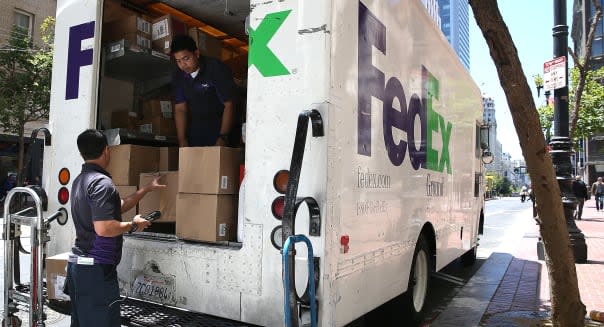FedEx Is Making Big Changes on How it Charges for Shipping

For years, whenever either FedEx (FDX) or United Parcel Service (UPS) changed rates for parcel delivery, the other wasted little time in duplicating the move. Of course, those moves always seemed to go in just one direction: up. And they're about to go up again.
Prices Based on Volume
Earlier this month, FedEx set the stage for a price hike of unprecedented scope. It will affect rates charged to consumers for delivery of packages low in weight, but large in size. Here's how the company explained it:
"Effective January 1, 2015, FedEx Ground will apply dimensional weight pricing to all shipments. Currently, FedEx Ground applies dimensional weight pricing only to packages measuring three cubic feet or greater."
If the phrase three "cubic feet" sounds confusing, try to picture three boxes, each measuring 12 inches on each side, laid out in a line. Mathematically, this works out to 12 x 12 x 36 (the combined length of the three boxes) = 5,184 cubic inches -- or three cubic feet -- in all. So FedEx is saying that any box smaller than this will be priced at the new rates.
FedEx continues:
"This change will align the FedEx Ground dimensional weight pricing with FedEx Express by applying it to all packages. Dimensional weight pricing is a common industry practice that sets the transportation price based on package volume -- the amount of space a package occupies in relation to its actual weight."
What It Means to You
"Common industry practice" it might be. But it's still going shock consumers who, in recent years, have grown accustomed to the convenience of having online e-tailers such as Amazon.com (AMZN) and Staples.com (SPLS) deliver household essentials to their doorstep -- often for free.
%VIRTUAL-article-sponsoredlinks%By using programs such as Amazon Prime (which offers free delivery to its subscribers) or taking advantage of offers for "free delivery for orders" more than $25, $35 or $75 in value, for example, many consumers have discovered an easy alternative to lugging home bulky packages of toilet paper and paper towels from the grocery. They simply order online and have the parcels shipped directly to their homes.
That's convenient for them, but FedEx has apparently decided that these kinds of shipments aren't very profitable for it. Bulky-but-light packages take up more than their fair share of truck space -- space that FedEx would prefer to fill with extra packages that it can charge for. If history is any guide, UPS, the preferred private shipper of both Amazon and Staples, may soon come to the same conclusion.
So how much more will FedEx charge for these space-hogging packages under its new pricing scheme? Running a few simulations on FedEx's online rate finder webpage, it appears that the shipping cost of a bulky-but-light package such as a 40-roll box of Charmin Basic toilet paper, when charged by the volume it takes up -- could cost anywhere from 21 percent to 76 percent more than the same item cost when priced by weight. The difference in price varies according to the speed of delivery a customer chooses and the distance of shipment, but the average increase of all shipping methods available works out to about a 60 percent increase in price.
How Can You Beat the Rate Hike?
FedEx says it won't begin charging for delivery under its new system until Jan. 1 of next year. Even then, it may be possible to sidestep FedEx's rate hike by shipping your own packages via UPS or USPS, and buying only from e-tailers who use USPS or UPS for shipments. Once UPS mimics FedEx, though -- as it seems likely it will do -- things may get trickier. Here are some possible outcomes:
E-tailers will simply eat the additional cost of delivery themselves, perhaps negotiating discounts on the new rates with the shippers. In that case, you've got nothing to worry about.
E-tailers may scale back free shipping offers, perhaps by raising the dollar-value requirement to win free shipping on your purchases. In this case, the solution will also be relatively simple: Buy in bulk, grouping the items you buy into fewer batches.
E-tailers build the shipping costs into the prices they advertise for the goods. This will require you to become particularly diligent about comparing prices among competing e-tailers so as not to get taken advantage of.
You continue shopping online to your heart's content when buying "heavy" goods. But when it comes to bulky-but-light items such as toilet paper and paper towels, go back to the old method: Drive to the grocery store yourself to pick 'em up -- or have the grocer deliver them to you directly.
Motley Fool contributor Rich Smith has no position in any stocks mentioned. The Motley Fool recommends Amazon.com, FedEx and United Parcel Service. The Motley Fool owns shares of Amazon.com and Staples. You can try any of our newsletter services free for 30 days.

